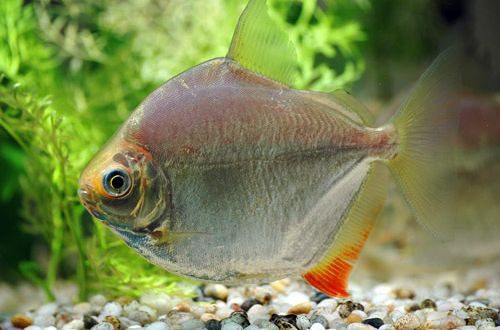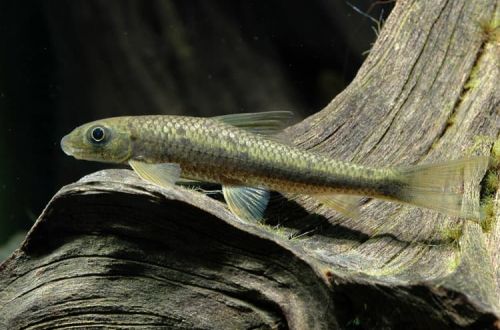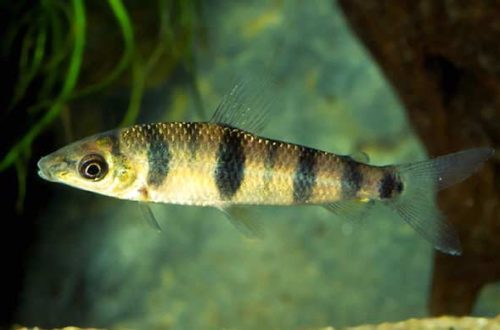
Tetra-Phantom
Tetra phantom or Ornatus black, scientific name Hyphessobrycon megalopterus, belongs to the Characidae family (Characinidae). It has been one of the most popular aquarium fish for many years. Well studied and successfully bred at home, it can be recommended to beginner aquarists.

Contents
Habitat
The tetra phantom received a scientific description in 1915, discovered in South America in Paraguay. Widespread in river systems across the continent. The natural habitat is clear clear waters with dense vegetation, also found in swampy regions. They feed on worms, small crustaceans and insects.
Description
It has a classic Tetra body shape – somewhat oval and laterally pressed, with a large anal fin. This species also has a high dorsal fin, and in males it is higher. Smoky black coloration with a silvery belly. The fins are light, but have a dark edging. The body is decorated with a large dark spot behind the gills.
Food
Ornatus black belongs to omnivorous species, with pleasure uses all types of dry industrial and meat feed. A balanced diet, in addition to granules and flakes, must include meat products (pieces of worms, bloodworms, brine shrimp, etc.). On sale there are special foods for Tetras that already contain freeze-dried meat additives, which reduces the hassle of the aquarist when feeding.
Maintenance and care
It is necessary to establish a certain composition of water – soft and slightly acidic. It is more efficient to maintain the acidity level with the help of filters, where peat is used as a filter material, in this case the water is not only purified, but also acidified. Once every two weeks, part of the water should be renewed (by about 25–30%) with fresh water. Fish do not like bright light, so subdued lighting is welcome.
In the design, define two clear zones – a swimming area and dense thickets of plants along the side and back walls of the aquarium. Floating plants will provide additional shade. The soil is dark from river sand and fine gravel. They also use decorative items made of wood (snags, tree branches, roots, etc.). The addition of dry leaves will turn the water a light brown color, which is typical for the natural habitat. Leaves are replaced every two weeks, for example, combined with the process of water renewal.
Social behavior
The Phantom Tetra is a peaceful and friendly fish, perfectly compatible with other species that are similar in temperament. Keeping in groups of at least 6 individuals, males often arrange “showdowns”, but they are purely demonstrative in nature, no injuries occur. The fish are quite shy, so caution is not a problem, an accidental blow to the glass or a loud sound can cause a panic attack.
Sexual differences
The female is distinguished by a more saturated color of the adipose, pectoral and anal fins, the male is noticeably paler, but has a high dorsal fin.
Breeding / breeding
Breeding is advisable to carry out in a separate spawning aquarium from 20 liters, filled to three-quarters of the total volume. Groups of low plants, no more than 4-5 cm high, and free space between elements such as snags, roots, etc. are required in the design. Water parameters: temperature not lower than 25 ° C, pH – 6.0, soft (dH – 4°). Of the equipment, a weak filter, a heater.
Spawning can start at any time, stimulated by good meat/live food for several weeks. Males become brighter, and in females, the abdomen noticeably increases – it swells from caviar. At this point, they are transplanted into a spawning aquarium.
After a short courtship procedure, the female releases eggs into the water, and the male fertilizes them. All this happens above the thickets of plants, where the eggs subsequently fall. If the plants are located in several groups, the pair will spawn in several zones at once. At the end of the fish return to the general aquarium.
There should be no artificial lighting in the spawning aquarium, on the contrary, after removing the parents, it can be covered with a towel so that a minimum of light gets in – this protects the eggs from being damaged by a fungus to which there is a predisposition. It should be kept in the dark for about a day or two, during which time the fry have time to appear. Feed powdered feed, nauplii, brine shrimp.
Diseases
In aquariums with high water quality and constant care, the likelihood of disease outbreaks is very low. Read more about symptoms and treatments in the Aquarium Fish Diseases section.





